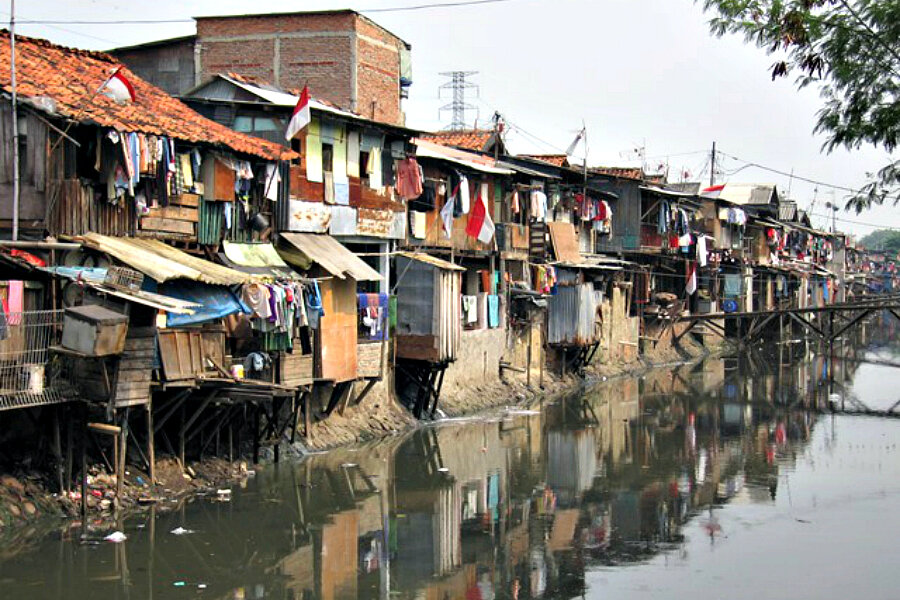In a slum in Kenya, help is just a click away
Loading...
One of the toughest development challenges today is the prevalence of urban slums. Despite countless efforts to improve living conditions, slums are an unstoppable force – fed by rapid urbanization, housing shortages, and boundless population growth.
In Nairobi, where 60 percent of residents live in slums, neglect by authorities is commonplace. Yet with the help of a social enterprise, activist slum dwellers are saying, there’s an app for that!
The word "slum" brings to mind crowded streets of makeshift shacks and abject poverty. In reality, they are also thriving communities, which host families, informal entrepreneurs, and as much as 80 percent of the population in cities around the world. With greater support from governments and civil society organizations, many slums could become desirable, highly functioning communities, argued Rahul Srivastava and Matias Echanove in The Guardian.
Like others around the world, the slums in Nairobi, Kenya, face daunting challenges. The settlements lack even the most basic infrastructure, like schools, clean water, and sanitation services, and yet city officials drag their feet providing money for repairs or improvements.
In the Mathare slum, residents grew tired of waiting for the government to act and took matters into their own hands.
How? Technology.
In 2013, the Kenyan social enterprise Spatial Collective teamed up with residents to create a map of the settlement using GPS technology. The map provided a detailed picture of life in the slums, marking everything from storefront churches to illegal dumping grounds.
Map making is not typically at the center of development ventures, but it served as a perfect starting point for improving the lives of Mathare’s residents. In addition to providing a sense of place to a community with no street names, it also –- perhaps most importantly – served as a tool for negotiating with and pressuring government authorities on various development projects.
Residents like Emily Wangari, a member of Slum Dwellers International, hoped that mapping technologies would help bring awareness to the problems in her neighborhood. Having only four toilets for its 4,000 residents is a growing source of disease and one of the issues Emily wants addressed.
Waste management was another top priority for the community. At the time, residents who could afford it paid youth groups to collect their trash and drop it off at the city’s largest dump, Dandora. This particular dump has been full for 14 years and while city trucks are supposed to relocate the surplus, they rarely show up. Trash overflows into the streets and nearby river.
The team at Spatial Collective conducted household surveys and utilized GPS technology to map disparities in access to waste services, where trash was being dumped, and who was paying for it.
“Collecting 300, 400, 500 incidents allows you to reveal trends and then share that with decision makers,” explained Jamie Lundine, the Co-Founder and Managing Director at Spatial Collective. “Visualizing them and showing this is a hot spot area, for example, might move somebody.”
With this new-found data, the map pressured city collectors to work more closely with the youth groups and ultimately ensure the garbage at Dandora was relocated.
Recently, locals decided to take this project a step further and created a mobile app – again with a little help from the “map-crazy folks” at Spatial Collective. In 2014, surveys showed that 40 percent of the population within the slum had a smartphone. The goal was to develop a more participatory platform for residents to voice their concerns about infrastructure and land tenure disputes throughout the community.
Locals use the mobile app to report problems they see in their neighborhood and can even rate the level of urgency, so that prompt and proper action can be negotiated by Spatial Collective and other invested organizations. Combining the mobile app with the map allowed for the clarification of household boundaries, as well as pinpointing the location of the reported problems.
The installation of street lamps in dark, crime-ridden corners of the slum, was one of the first victories for the mobile app users.
“The slums were sort of invisible to the rest of the world, but with technology you can really bring those issues into the limelight,” said Spatial Collective’s Co-Founder, Primoz Kovacic. “If they say something through this technology, they are going to be heard as opposed to before when they were just shouting into the air and nobody heard them.”
GPS and mobile app technologies may seem like simple solutions to such complex problems. However, Spatial Collective and the local residents prove that these solutions offer a gateway to improvements. For one, they have opened the possibility for statistical representation, including household surveys and high quality data that can only improve the strength of development ventures.
Yet most of all, Mathare residents now carry solid proof of the everyday challenges they face in the slum.
• This article originally appeared at Global Envision, a blog published by Mercy Corps.





